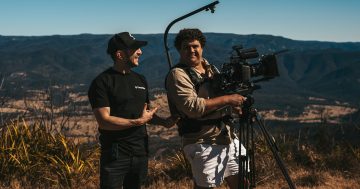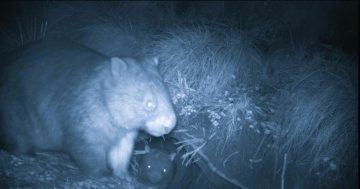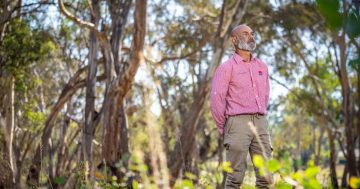
Frogs were the surprise survivors of the Black Summer bushfires. Photo: Kim Treasure.
When we returned to our bushfire-ravaged rural home at Malua Bay, on the NSW South Coast, on New Year’s Day, the last thing we expected to find were tiny green survivors in the blackened ruins of our garden. The only patch of colour was an old rhubarb plant, and tucked right at the base of its shrivelled leaves were tiny green frogs. For me, they were a welcome sign of nature’s resilience and the surprise survivors of a firestorm.
Research from the Australian Museum and UNSW Sydney, published this week in the Conservation Science and Practice journal, reveals many frog species in southeastern Australia survived the unprecedented 2019-2020 summer bushfires.
By area burnt, the past bushfire season was the largest in southeastern Australia since European occupation, and that’s had a dramatic impact on biodiversity, including frogs.
The amphibians are one of the most threatened groups of animals on earth and face many risks, including the growing threat of fires due to the climate crisis.
However, Dr Jodi Rowley, lead author of the research paper and chief scientist of FrogID, says we don’t know enough about frogs’ response to fire.
“There are limited studies on the impact of fire on Australian frogs so we urgently needed real-time data to understand how frogs fared after the fires, and to make sure we manage their conservation effectively,” she says.
The massive size of the bushfire zone made it nearly impossible for scientists alone to survey for frogs in the months after the blazes.
However, by working with a team of thousands of citizen scientists using FrogID, scientists at the Australian Museum and UNSW were able to reveal that many frog species have remarkably persevered through the fire events.
FrogID is the Australian Museum’s flagship national citizen science project that enables anyone to record and upload frog calls, along with time and location data, using a free app. By matching each FrogID record with satellite data on the bushfires, scientists were able to get a snapshot of the short-term persistence of frog species across southeastern Australia, up to four months after the Black Summer bushfires.
“Before the bushfires, FrogID recorded 2655 observations of 66 frog species in the fire zone, compared to 632 observations of 45 frog species in the first few months after the bushfires,” says Dr Rowley.
“This research is really positive news, but the full impact of these fires on Australian frogs will not be evident for some time.
“The ability of Australian frogs to recover from this catastrophic event is unclear, particularly when you consider all the threats faced by frogs, including habitat modification, climate change and disease, to name just a few.
“Continued use of FrogID, combined with scientific surveys, will allow a greater understanding of the impact of the fires on these frog species in the immediate aftermath and further into the future. So keep on recording frogs, Australia.”
The frog species recorded in burnt areas post-bushfire included common species of low conservation concern, as well as rare and threatened species including the threatened southern barred frog (Mixophyes balbus) and mountain frog (Philoria kundagungan).
Dr Corey Callaghan, postdoctoral research fellow at UNSW and co-author of the study, says the research provided a new understanding of how frogs respond to fire, illustrating the value of citizen science in collecting large-scale and rapid observations in response to the climate crisis and related natural disasters such as bushfires.
“Citizen science data is rapidly advancing our ecological knowledge,” he says. “This research is a unique case, demonstrating the ability of citizen scientists to provide data that furthers understanding of biodiversity responses to bushfires.”
The scientists say it’s more important than ever for Australians to take part in the nation’s biggest frog count.
FrogID Week runs from 6-15 November, 2020. Anyone can take part and it is easy to get involved. Simply download the free FrogID app and head outside to listen for frogs. When you hear a frog, record the sound with the FrogID app and submit it to the FrogID program.
Find out more at FrogID.











